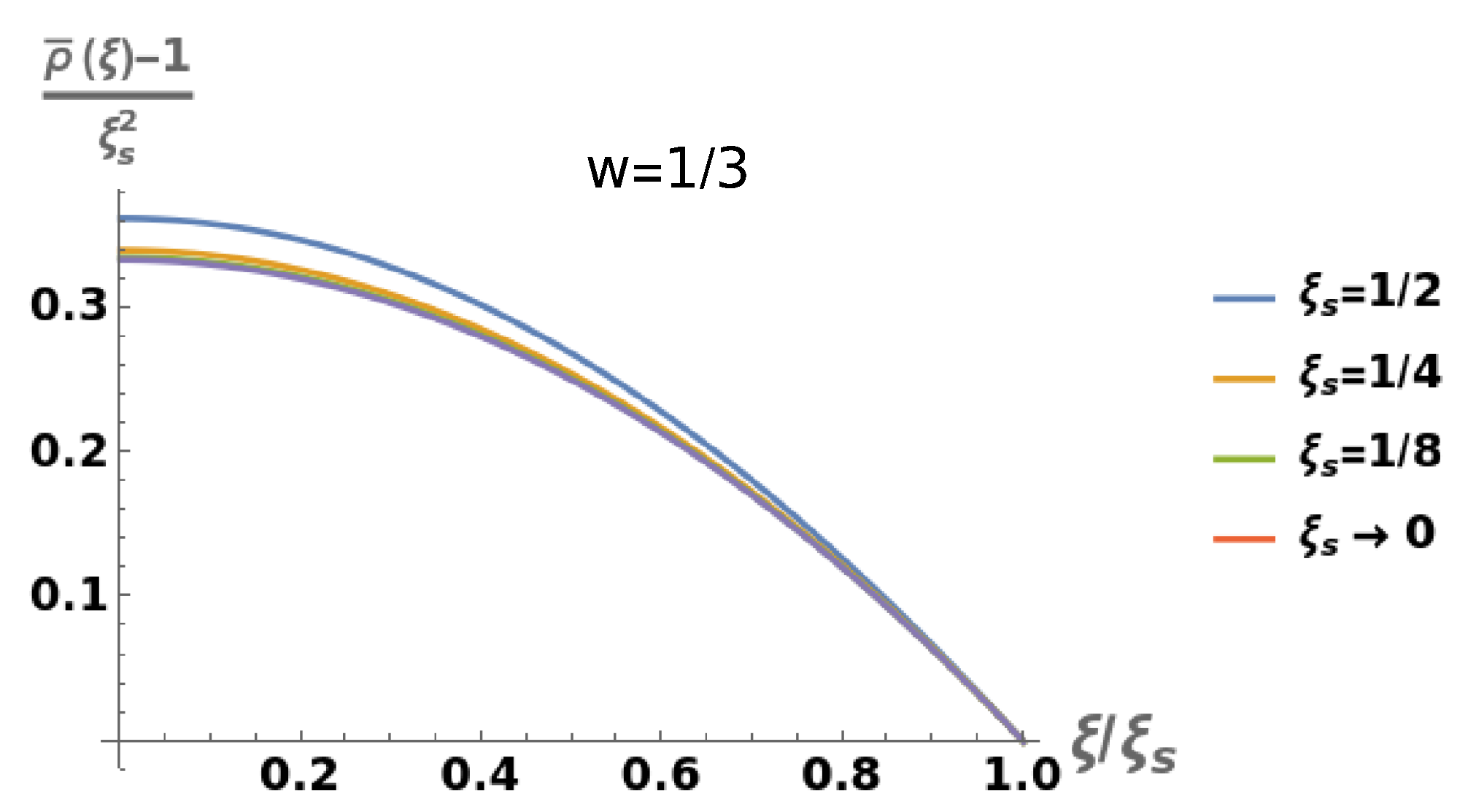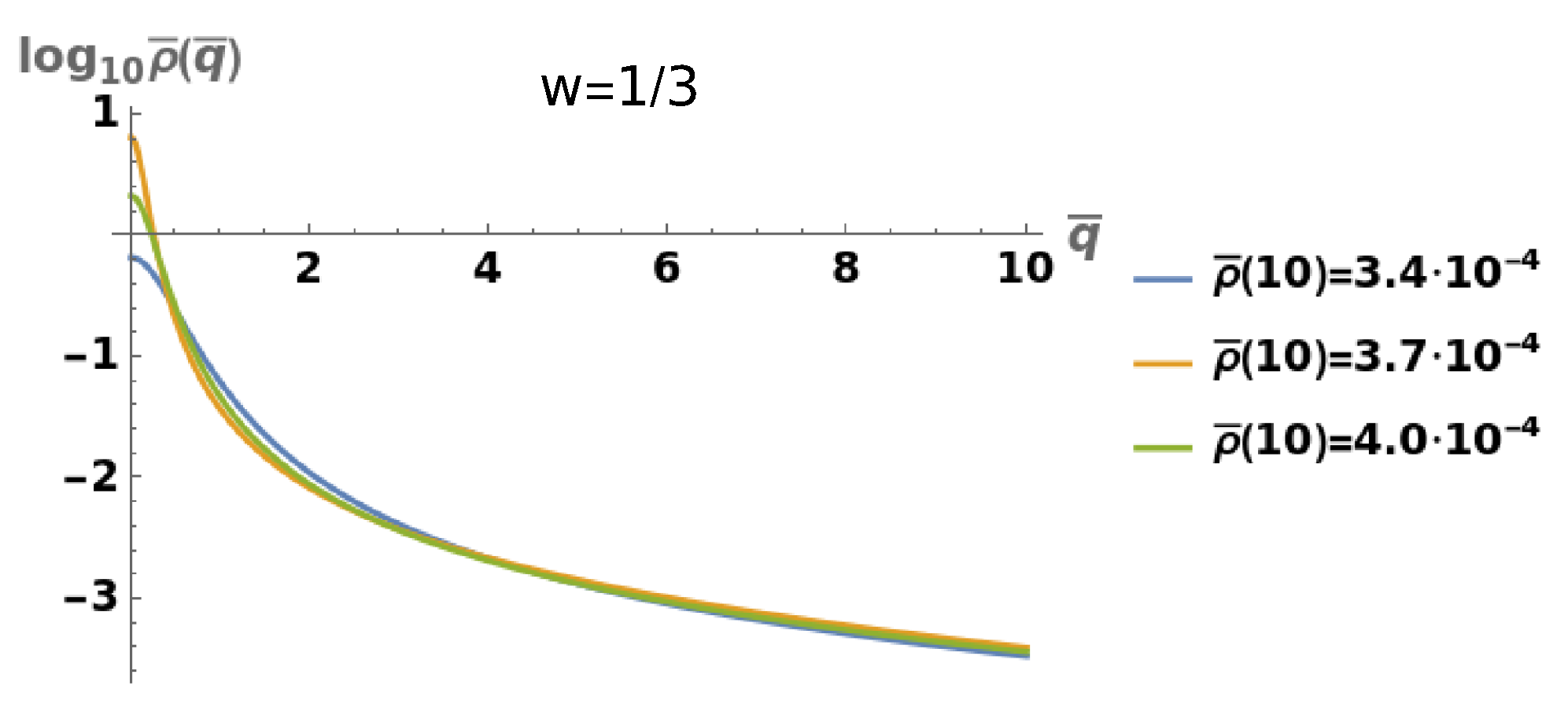A Metric Approach to Newtonian Cosmology and Its Applications to Gravitational Systems
Abstract
1. Introduction
2. Newtonian Derivation of Friedmann Equations: A Review
3. Dynamical Equations in the Newtonian Approach
- Scalar perturbations, which capture Newtonian behavior already at first order.
- Vector perturbations, linked to the shift vector in GR, which also appear at first order but diminish quickly due to the universe’s expansion (whereas in a static background, they arise only at second order).
- Tensor perturbations, whose effects become relevant only at second order in perturbation theory, and at third order in static scenarios.
- As we will see, our approach falls within the framework of so-called metric theories of gravity, [18,22,23,24] where, in page 19 of [18], the authors assume that a metric theory of gravity must satisfy the following two postulates:
- (a)
- Spacetime is endowed by a metric .
- (b)
- The conservation law of the stress–energy tensor
or as in Ref. [24]- (a)
- Spacetime is endowed by a metric .
- (b)
- World lines of test bodies are geodesics.
- (c)
- In local freely falling frames, the non-gravitational laws of physics are those of special relativity.
In this context, we choose the “prior metric” (12), for which the spatial slices are conformally flat, and the conservation of the stress-energy tensor is imposed. Consequently, in addition to the vanishing divergence of the stress-energy tensor, we require an equation to determine . As we will shortly demonstrate, this equation will generalize the first Friedmann equation. - To have an intuitive idea about the choice of the metric (12), we apply the the Principle of Equivalence to a uniform gravitational field, namely , and we seek a metric that reproduces Newton’s second law:being the inertial force and the gravitational one, where denotes the acceleration of the body, and we have used the equality of the inertial and gravitational mass. To achieve this, we consider the static line element:and from the minimization of the action , we find the following:In order to derive the Newtonian equation, it is necessary to impose the condition that the velocity term on the right-hand side vanishes. This condition is fulfilled when , where C is a constant. Without loss of generality, this constant can be set to unity through an appropriate rescaling of the coordinates. Accordingly, we obtain the following:and comparing with (13) we find thatwhere b is a constant which must be equal to 1 in order to recover the Minkowski metric when the acceleration vanishes. This concludes that, for a uniform gravitational field described by , the motion of a freely falling object follows Newton’s second law when the acceleration represents the particle’s proper acceleration. Moreover, we can say that the object does not feel its own weight, since the proper inertial force exactly cancels out the gravitational force as described by Newtonian mechanics.
3.1. First Friedmann Equation
3.2. Conservation Laws
- where is the scalar product of the vectors and .
4. Conformastat Metric: Classical Tests
4.1. Dynamical Equation of Test Particles
4.2. Metric Produced by a Point Mass Particle
Precession of the Perihelion
- The non-homogeneous first Friedmann equation obtained in Section III A.
- The Newtonian formulation of the momentum constraint, which—if we aim to align with the PPN approach—leads us to adopt Equation (103), or, alternatively, if we seek a framework independent of the GR field equations, the Lorentz transformations indicate that Equation (89) should be chosen as the shift vector.
- The energy density conservation equation.
- The relativistic Euler equation.
- The Newtonian scale factor .
- Components of the shift vector.
- Energy density .
- Three-velocity components of the fluid
- Pressure (through the equation of state ).
5. Conformastat Metric: Stellar Equilibrium
5.1. Linear Equation of State
5.1.1. Exact Solution
5.1.2. Analytic Solutions
- . The Lane-Emden equation becomeswhose solution is , where taking into account the boundary condition , one has:In terms of the q-coordinate:which, of course, coincides with the case of a constant energy density, because implies .
- . The Lane-Emden equation becomeswhose solution is for , where is the radius of the star in the -coordinate.The mass acquires the form:and the relation at the boundary , leads to:Combining both expressions, we find:whose solution is:provided that, . Therefore, fixing one finds the parameter , and sincewe conclude that, fixing and the mass M, one finds the value of the parameters A, and the radius of the star .
5.1.3. Weak Field Approximation
6. Newtonian Gravitational Collapse
Gravitational Collapse in a Conformastat Metric
7. Conclusions
Author Contributions
Funding
Data Availability Statement
Acknowledgments
Conflicts of Interest
References
- Einstein, A. The Meaning of Relativity; Princeton University Press: Princeton, NJ, USA, 1953. [Google Scholar]
- Pauli, W. Theory of Relativity, Dover Books on Physics; Pergamon Press: Oxford, UK, 1981. [Google Scholar]
- Landau, L.D.; Lifschits, E.M. The Classical Theory of Fields; Course of Theoretical Physics; Pergamon Press: Oxford, UK, 1975; Volume 2. [Google Scholar]
- Weinberg, S. Gravitation and Cosmology: Principles and Applications of the General Theory of Relativity; John Wiley and Sons: New York, NY, USA, 1972. [Google Scholar]
- Friedman, A. On the Curvature of space. Z. Phys. 1922, 10, 377–386. [Google Scholar] [CrossRef]
- Friedmann, A. On the Possibility of a world with constant negative curvature of space. Z. Phys. 1924, 21, 326–332. [Google Scholar] [CrossRef]
- McCREA, W.H.; Milne, E.A. Newtonian universes and the curvature of space. Q. J. Math. 1934, os-5, 73–80. Available online: https://academic.oup.com/qjmath/article-pdf/os-5/1/73/4481663/os-5-1-73.pdf (accessed on 13 March 2025). [CrossRef]
- Callan, C.; Dicke, R.H.; Peebles, P.J.E. Cosmology and Newtonian Mechanics. Am. J. Phys. 1965, 33, 105–108. [Google Scholar] [CrossRef]
- de Haro, J. Relations between Newtonian and Relativistic Cosmology. Universe 2024, 10, 263. [Google Scholar] [CrossRef]
- Newton, I. Philosophiae Naturalis Principia Mathematica. 1687. Available online: https://www.loc.gov/item/28020872 (accessed on 13 March 2025).
- Minazzoli, O.; Harko, T. New derivation of the Lagrangian of a perfect fluid with a barotropic equation of state. Phys. Rev. D 2012, 86, 087502. [Google Scholar] [CrossRef]
- de Haro, J.; Elizalde, E.; Pan, S. On the Perturbed Friedmann Equations in Newtonian Gauge. Universe 2025, 11, 64. [Google Scholar] [CrossRef]
- Einstein, A. How I created the theory of relativity. Phys. Today 1982, 35, 45–47, lecture given in Kyoto on December 14, 1922. [Google Scholar]
- Norton, J. What was einstein’s principle of equivalence? Stud. Hist. Philos. Sci. A 1985, 16, 203–246. [Google Scholar] [CrossRef]
- Schwartz, H.M. Einstein’s comprehensive 1907 essay on relativity, part III. Am. J. Phys. 1977, 45, 899–902. Available online: https://pubs.aip.org/aapt/ajp/article-pdf/45/10/899/11719726/899_1_online.pdf (accessed on 13 March 2025). [CrossRef]
- Wilczek, F. Total relativity: Mach 2004. Phys. Today 2004, 57, 10–11. [Google Scholar] [CrossRef]
- Elizalde, E.; Barcelona, E. Symmetry & Cosmology: The Birth of an Equation for the Universe. Symmetry 2023, 15, 1470. [Google Scholar] [CrossRef]
- Thorne, K.S.; Will, C.M. Theoretical Frameworks for Testing Relativistic Gravity. I. Foundations. Astrophys. J. 1971, 163, 595. [Google Scholar] [CrossRef]
- The Berlin Years: Writings, Volume 6, 108–110 (1914–1917). Available online: https://einsteinpapers.press.princeton.edu/vol6-trans/ (accessed on 13 March 2025).
- Einstein, A. The Field Equations of Gravitation, Sitzungsber. Preuss. Akad. Wiss. Berlin (Math. Phys.) 1915, 1915, 844–847. [Google Scholar]
- Fock, V. The Theory of Space, Time and Gravitation; Pergamon: Oxford, UK, 2015. [Google Scholar]
- Will, C.M. Theoretical Frameworks for Testing Relativistic Gravity. II. Parametrized Post-Newtonian Hydrodynamics, and the Nordtvedt Effect. Astrophys. J. 1971, 163, 611. [Google Scholar] [CrossRef]
- Ni, W.-T. Theoretical Frameworks for Testing Relativistic Gravity.IV. a Compendium of Metric Theories of Gravity and Their POST Newtonian Limits. Astrophys. J. 1972, 176, 769. [Google Scholar] [CrossRef]
- Will, C.M. Theory and Experiment in Gravitational Physics, 2nd ed.; Cambridge University Press: Cambridge, UK, 2018. [Google Scholar]
- Norton, J.D. Einstein’s conflicting heuristics: The discovery of general relativity. In Thinking About Space and Time: 100 Years of Applying and Interpreting General Relativity; Beisbart, C., Sauer, T., Wüthrich, C., Eds.; Springer International Publishing: Cham, Switzerland, 2020; pp. 17–48. [Google Scholar]
- Straumann, N. Einstein’s ‘Zurich Notebook’ and his Journey to General Relativity. Annalen Phys. 2011, 523, 488–500. [Google Scholar] [CrossRef]
- Corichi, A.; Núñez, D. Introduction to the ADM formalism. Rev. Mex. Fis. 1991, 37, 720–747. [Google Scholar]
- Mukhanov, V. Physical Foundations of Cosmology; Cambridge University Press: Oxford, UK, 2005. [Google Scholar]
- Synge, J.L. Relativity: The General Theory, North-Holland Series in Physics, v. 1; North-Holland Publishing Company: Amsterdam, The Netherlands, 1960. [Google Scholar]
- Hilbert, D. The Foundations of Physics. Nachr. Ges. Wiss. Göttingen 1917, 53–76. [Google Scholar]
- Droste, J. The field of a single centre in Einstein’s theory of gravitation, and the motion of a particle in that field. Proc. K. Ned. Akad. Wet. Ser. A 1917, 19, 197–215. [Google Scholar] [CrossRef]
- Einstein, A.; Grassmann, M. Outline of a generalised theory of relativity and of a theory of gravitation. Z. Fur Math. Phys. 1913, 62, 225–261. [Google Scholar]
- Schwarzschild, K. On the gravitational field of a mass point according to Einstein’s theory, Sitzungsber. Preuss. Akad. Wiss. Berlin (Math. Phys.) 1916, 1916, 189–196. Available online: http://arxiv.org/abs/physics/9905030 (accessed on 13 March 2025).
- Eddington, A.S. The Mathematical Theory of Relativity; The University Press: Cambridge, UK, 1930. [Google Scholar]
- Johns, O.D. Validity of the Einstein hole argument. Stud. Hist. Philos. Mod. Phys. 2019, 68, 62–70. [Google Scholar] [CrossRef]
- Magnan, C. Complete calculations of the perihelion precession of Mercury and the deflection of light by the Sun in general relativity. arXiv 2007, arXiv:0712.3709. [Google Scholar]
- Gourgoulhon, E. 3+1 formalism and bases of numerical relativity. arXiv 2007, arXiv:gr-qc/0703035. [Google Scholar]
- Balakrishna, J.; Bondarescu, R.; Moran, C.C. Self-gravitating stellar collapse: Explicit geodesics and path integration. Front. Astron. Space Sci. 2016, 3, 29. Available online: http://arxiv.org/abs/1501.04250 (accessed on 13 March 2025). [CrossRef][Green Version]


Disclaimer/Publisher’s Note: The statements, opinions and data contained in all publications are solely those of the individual author(s) and contributor(s) and not of MDPI and/or the editor(s). MDPI and/or the editor(s) disclaim responsibility for any injury to people or property resulting from any ideas, methods, instructions or products referred to in the content. |
© 2025 by the authors. Licensee MDPI, Basel, Switzerland. This article is an open access article distributed under the terms and conditions of the Creative Commons Attribution (CC BY) license (https://creativecommons.org/licenses/by/4.0/).
Share and Cite
de Haro, J.; Pan, S. A Metric Approach to Newtonian Cosmology and Its Applications to Gravitational Systems. Symmetry 2025, 17, 1000. https://doi.org/10.3390/sym17071000
de Haro J, Pan S. A Metric Approach to Newtonian Cosmology and Its Applications to Gravitational Systems. Symmetry. 2025; 17(7):1000. https://doi.org/10.3390/sym17071000
Chicago/Turabian Stylede Haro, Jaume, and Supriya Pan. 2025. "A Metric Approach to Newtonian Cosmology and Its Applications to Gravitational Systems" Symmetry 17, no. 7: 1000. https://doi.org/10.3390/sym17071000
APA Stylede Haro, J., & Pan, S. (2025). A Metric Approach to Newtonian Cosmology and Its Applications to Gravitational Systems. Symmetry, 17(7), 1000. https://doi.org/10.3390/sym17071000







